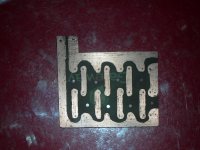athousandgoodintentions
New Member
New poster, long time lurker, and thanks for this forum, you guys have helped me through a lot of problems on my cafe build.
One question I always had, never found a good answer to, then discovered on my own and vowed to share the answer, was battery elimination.
My setup works perfectly, no flicker at idle, and the world needs to know it.
I wired a set of three, 6800 microfarad caps in parallel, where a battery would be. Probably overkill, but amazon sold them in sets of three, for just a few bucks, and overkill doesn't fail. I made em into a tidy little pack that tucks flat under the seat.
For a headlight I went with a snazzy Chinese LED that uses 24 watts on low, 30 on high, and honestly throws a better beam than the stock light. Couldn't be happier.
I replaced my tail light with a red LED simple generic swapout.
For kicks, I replaced my horn with a 110 decibel piezo disk. It sounds like a forklift, but plenty loud, and who uses horns outside of a vehicle inspection anyway? It uses a tenth of a watt, cost four dollars. A stock horn cost ten dollars and uses four watts. Same volume, different pitch.
And that's it. Even at a cold idle, I can run the headlight and brake, no flicker. Maybe it's those overkill microfarads?
I did hook up the "high beam" coil in the alt so it's always on, all the time. I also replaced the wiring harness with (don't laugh) household extension cord wire (overkill again, my reading all seemed to indicatevoltage drop and insufficient charge as real problems so I swung wide into caution) my entire circuit is just a hot line from the caps to the headlight (ignition taps in and powers the coils, the rest stays on because with caps it doesn't matter) and the headlight hots also power the tail. The brake circuit is unchanged. I drilled into the frame tubes and fished all the wiring internally for a clean look.
So, at least from this guy, no more conjecture. A 1971 CB350 does not need a battery, and the swap can be done by an average Joe for eight bucks in parts.
One question I always had, never found a good answer to, then discovered on my own and vowed to share the answer, was battery elimination.
My setup works perfectly, no flicker at idle, and the world needs to know it.
I wired a set of three, 6800 microfarad caps in parallel, where a battery would be. Probably overkill, but amazon sold them in sets of three, for just a few bucks, and overkill doesn't fail. I made em into a tidy little pack that tucks flat under the seat.
For a headlight I went with a snazzy Chinese LED that uses 24 watts on low, 30 on high, and honestly throws a better beam than the stock light. Couldn't be happier.
I replaced my tail light with a red LED simple generic swapout.
For kicks, I replaced my horn with a 110 decibel piezo disk. It sounds like a forklift, but plenty loud, and who uses horns outside of a vehicle inspection anyway? It uses a tenth of a watt, cost four dollars. A stock horn cost ten dollars and uses four watts. Same volume, different pitch.
And that's it. Even at a cold idle, I can run the headlight and brake, no flicker. Maybe it's those overkill microfarads?
I did hook up the "high beam" coil in the alt so it's always on, all the time. I also replaced the wiring harness with (don't laugh) household extension cord wire (overkill again, my reading all seemed to indicatevoltage drop and insufficient charge as real problems so I swung wide into caution) my entire circuit is just a hot line from the caps to the headlight (ignition taps in and powers the coils, the rest stays on because with caps it doesn't matter) and the headlight hots also power the tail. The brake circuit is unchanged. I drilled into the frame tubes and fished all the wiring internally for a clean look.
So, at least from this guy, no more conjecture. A 1971 CB350 does not need a battery, and the swap can be done by an average Joe for eight bucks in parts.





